Updated 17 Apr 2012
|
WIRKSWORTH Parish Records 1600-1900
|
|
The Hope & Anchor Inn is a Grade 2 listed building at the centre
of Wirksworth,
address: 2, St John's St, Wirksworth, Derbyshire DE4 4ET,
described in 1950 as follows:
"Early C19 ashlar to early C17 coursed stone rubble exposed in rear gabled
dormers; 3 storeys; 7 sash windows; small stuccoed Roman Doric cornice hood
porch. Left-hand wing, formerly with modern shop front, now has plain inn
windows. Plain eaves. C19 cast-iron inn-sign. Contains enriched oak overmantel
with fluted Ionic shafts (the volutes upside down) flanking a bolection
moulding around fireplace and supporting an enriched cornice on consoles
with panels enriched with fleurs-de-lys, unicorns, Tudor Rose, etc. Of
crude execution and date circa 1610. The entrance lobby contains a small
section of a moulded plaster ceiling of the same date. The history of the
house is problematical, but it is vaguely associated with the Governor when
Wirksworth had a penal settlement."
|
Looking South down St John St. Postcard sent by
Mrs Frances E Woolley of Wirksworth (born 1850)
on 25 May 1904
to Miss Mary Nutt of Sherborne (born 1882).
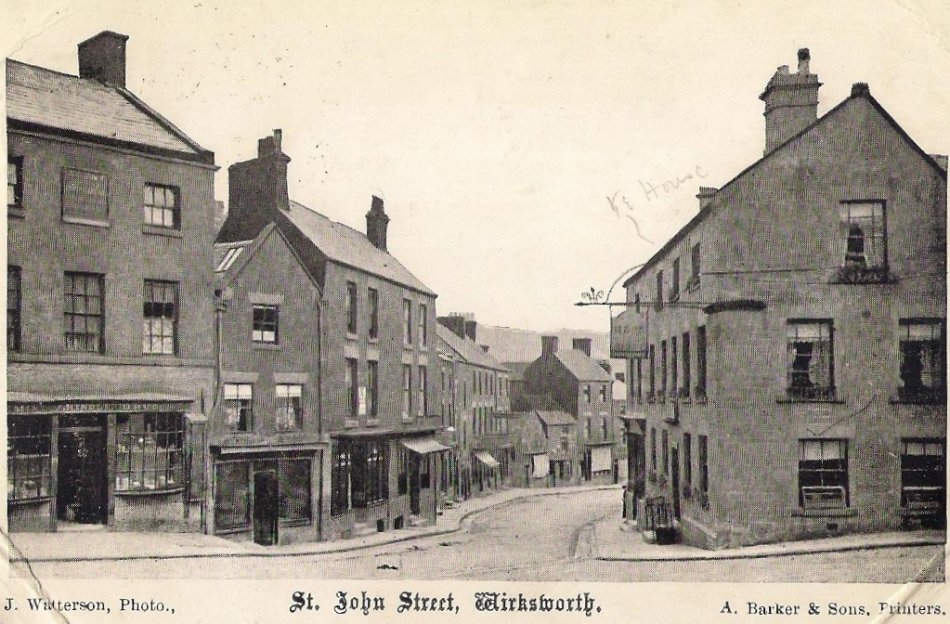
|
|
From a postcard posted 1926 in Wirksworth.
(See Hope and Anchor website)
Postcard addressed to:
"Mrs W Foulkes, Gable House, Bowler St, Marehay, Nr Derby"
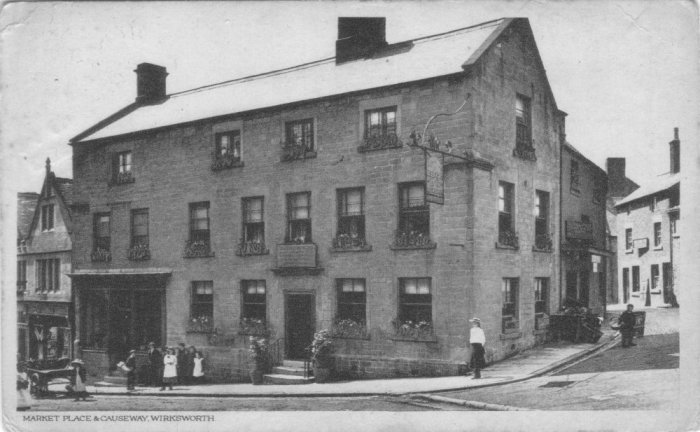
|
|
The Hope and Anchor drawn in 1979.
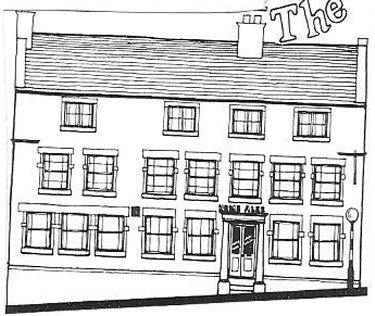
|
Dated 1920
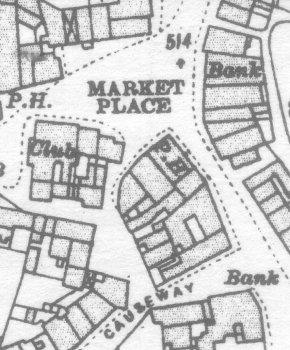
|
Dated 2000
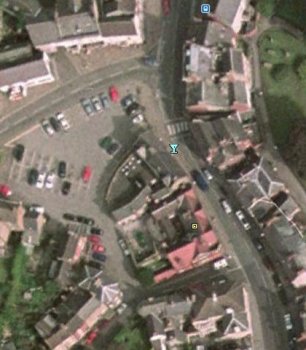
|
"At the bottom of the Market Place, set on an island site, is the Hope
and Anchor, a fine seventeenth century building. There is an ornate
plaster ceiling on the first floor and an elaborately carved wooden
fireplace in the lounge bar, probably dating from about 1660.
From: "Discover Derbyshire - Wirksworth and the surrounding area"
by Denis Eardley.
"The Hope and Anchor was kept by the Budworths who had owned it for a
generation. In fact an old Mr. Budworth was the first customer the Ind
Coope had when they started brewing at Burton. There are many tales to be
told about the Hope and Anchor. It was reputed to be the site of the Roman
Governor of the prison camp which they established here about 10 AD.
It features in Baroness Orczy’s book Beau Brocade and was the meeting place
of the Barmote Court. But, above all, it was a superior establishment
noted for its exclusive clientele (which never numbered more than a dozen)."
From Haworth webpage
Others who ran the H & A
1846 - ARDWICK
1835 Elizabeth HUNT
1827 Samuel POYSER
1821 Samuel POYSER
|
The BUDWORTHs who ran the H & A
Martha 61 1901 |
Martha 50 1891 |
Martha 41 1881
Henry 59 1871 |
Henry 49 1861 |
Henry 39 1851 |
Henry 30 1841
BUDWORTH family
1812 1812
Henry 1836 Eliza
BUDWORTH=====v=====PEAT
1877 | 1873
|
1838 1840
Henry Martha
BUDWORTH=====v=====
1873 | 1929
|
|--------|---|---|
| | |
1864 1866 1871
Eliza Mary James
Hannah Annie Phineas
|
|
This elaborate 17c fireplace
is in the former parlour.
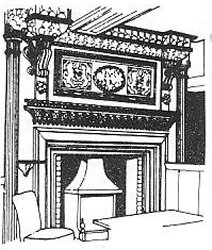
|
From Wirksworth and Five miles round,
by R R Hackett 1899:
We borrow the following description of the curious old Chimney Piece at
Mrs Budworth's, the "Hope and Anchor" Inn,
Wirksworth, from the OLD PARISH MAGAZINE:-
"In the centre of the Chimney Piece is an an Ellipse, within which are
four fleur-de-lis in cross, point to point.
The form is somewhat unusual. It may be remembered that there is a
difference of opinion as to the origin of the Fleur-de-lis, some believe
it to be the lily, or gillyflower, others to be a form of the Cronel,
or spear-head. On either side of the central elliptical panel is a
square panel on which are carved the raised figures of two Unicorns rampant,
holding between them a sceptre crowned with a fleur-de-lis, or perhaps a
spear with a fleur-de-lis or cronel above. These are the supporters of
the Royal Arms of the old Kingdom of Scotland, previous to the union with
England in 1603. Perhaps this Chimney-piece was put up immediately after
the union by the Chancellor of the Duchy of Lancaster, or his deputy,
out of compliment to the new Sovereign. The date seems certainly about
1600 to 1620.
"On either side of the panels is the Tudor Rose. The central part of the
chimney-piece is very bold and well carved, but the side pilasters appear
to be an addition of later times. They seem intended for Ionic, though
the capital is reversed, instead of being in the usual form, they are
correlated, but appear to be of a different wood, of somewhat paler
colour than the centre. The lowest tier of carving below the
mantel-shelf seems certainly intended for Corinthian.
"The ornaments which surmount the left hand Ionic columns are difficult
to decipher, they might be a cock's wattles, a star, a hedge-hog's back,
or two combs.
|
The shop in the corner.
The photo shows a bit of action:
A hand cart, a lady with hat and handbag, a delivery boy with
basket, 2 girls in white pinafores, 6 boys in dark clothes and
caps, slouching by the wall.
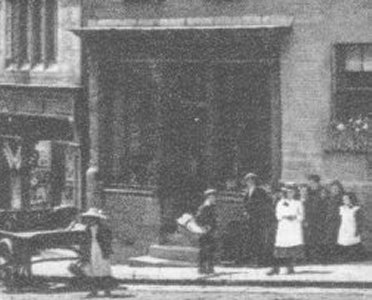
|
Tucked in the bottom left of the Hope and Anchor front
was a shop. Known as Palin's, and afterwards as Wheatcroft's,
it disappeared after 1926, and has now become the dining room
of the Hope and Anchor.
Bertram Haworth (1904-1998) describes his life in Wirksworth
Market Place around 1920, see theHaworth webpage.
Now across the street to Mr. Wheatcroft's. He was a fishmonger and
greengrocer. The shop has gone and now is an extension of the
"Hope and Anchor".
Approached by four stone steps, the shop was in two halves. Right side
was the wet fish on a marble slab, so arranged that the melting ice
could drain away through the window and so on to the pavement. Left side
was the green grocery. Turn left inside the door towards the counter,
quite unapproachable because in front I always remember - bags of potatoes
(red and white), bag of carrots and onions and swedes in season.
The counter itself held boxes of apples and oranges in season. This
made this area inaccessible, so you were served by Mrs. Wheatcroft, who
was quite small, suddenly appearing round the corner by the big scales.
Your modest orders and all financial transactions were completed on top
of an orange box which had three compartments. This was usually full to
overflowing and if you "accidentally touched" the bottom one of the
pile, a cascade of oranges resulted, and if you were really lucky, several
would roll down the steps and into the street. The fish came up by train,
packed in flat boxes filled with ice. The empties were kept outside under
the window, hence the pavement was always wet. Mr. Wheatcroft became a
councillor and became involved in a libel suit with our surveyor over his
plan to alter the Market Place (more later). He suffered financially.
Incidentally, he had two storage places, a small one which ran off what is
now the Church Yard from St John St. The other was in China House yard
and went underground.
|
"....We are now down to within 10ft of the Hope and Anchor. This area has also
changed. Where now is the dining room of the Hope and Anchor was a shop.
I remember it as Palin's, the green-grocer, in my early days - later they
moved across the Market. But, for many years after that, it was a baker's
shop kept by a Mr. Brough.
|
----Anyone with more details for publication on this webpage,
please email  ---- ----
|
|
Compiled, formatted, hyperlinked, encoded,
and copyright © 2010,
 All Rights Reserved.
All Rights Reserved.
|